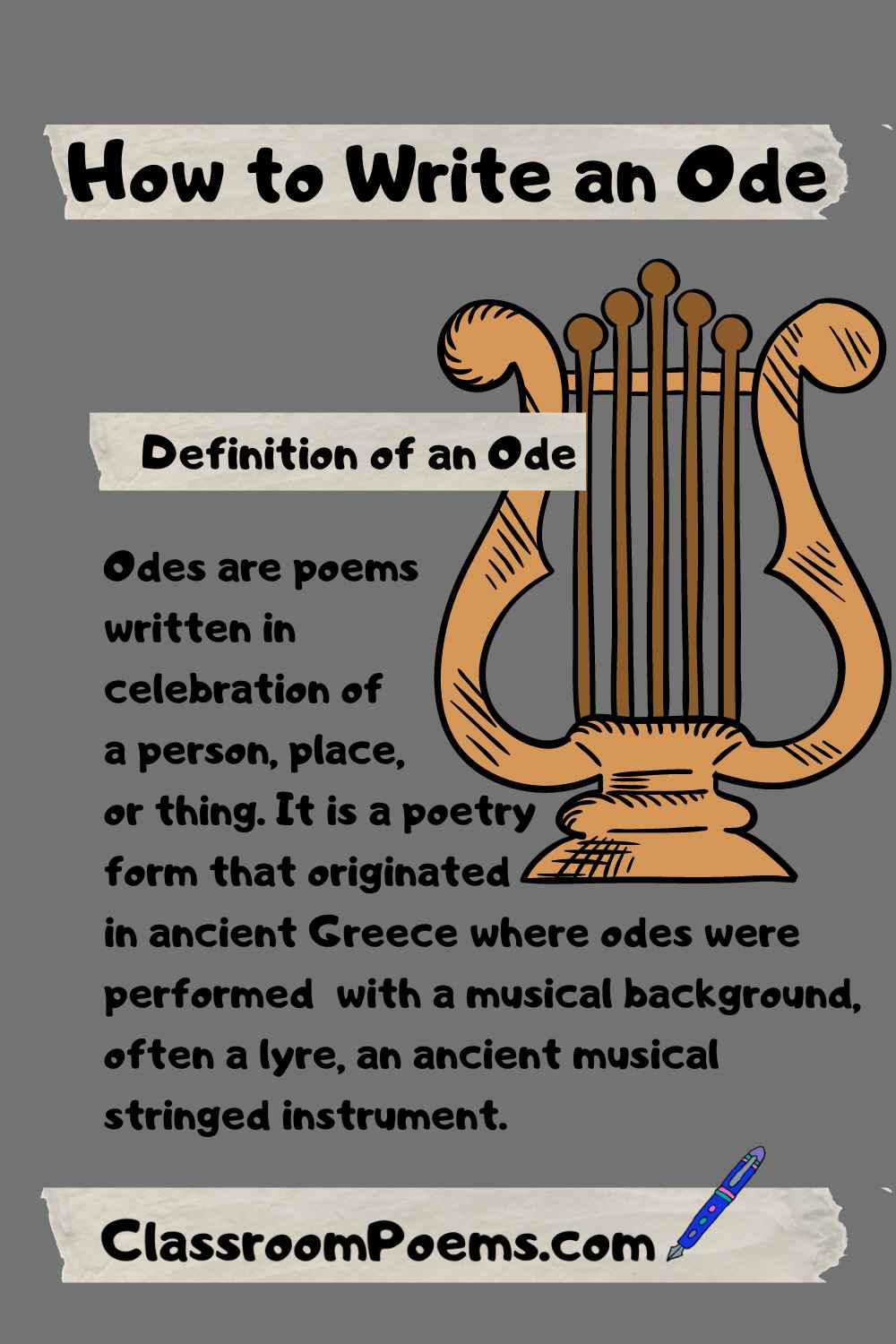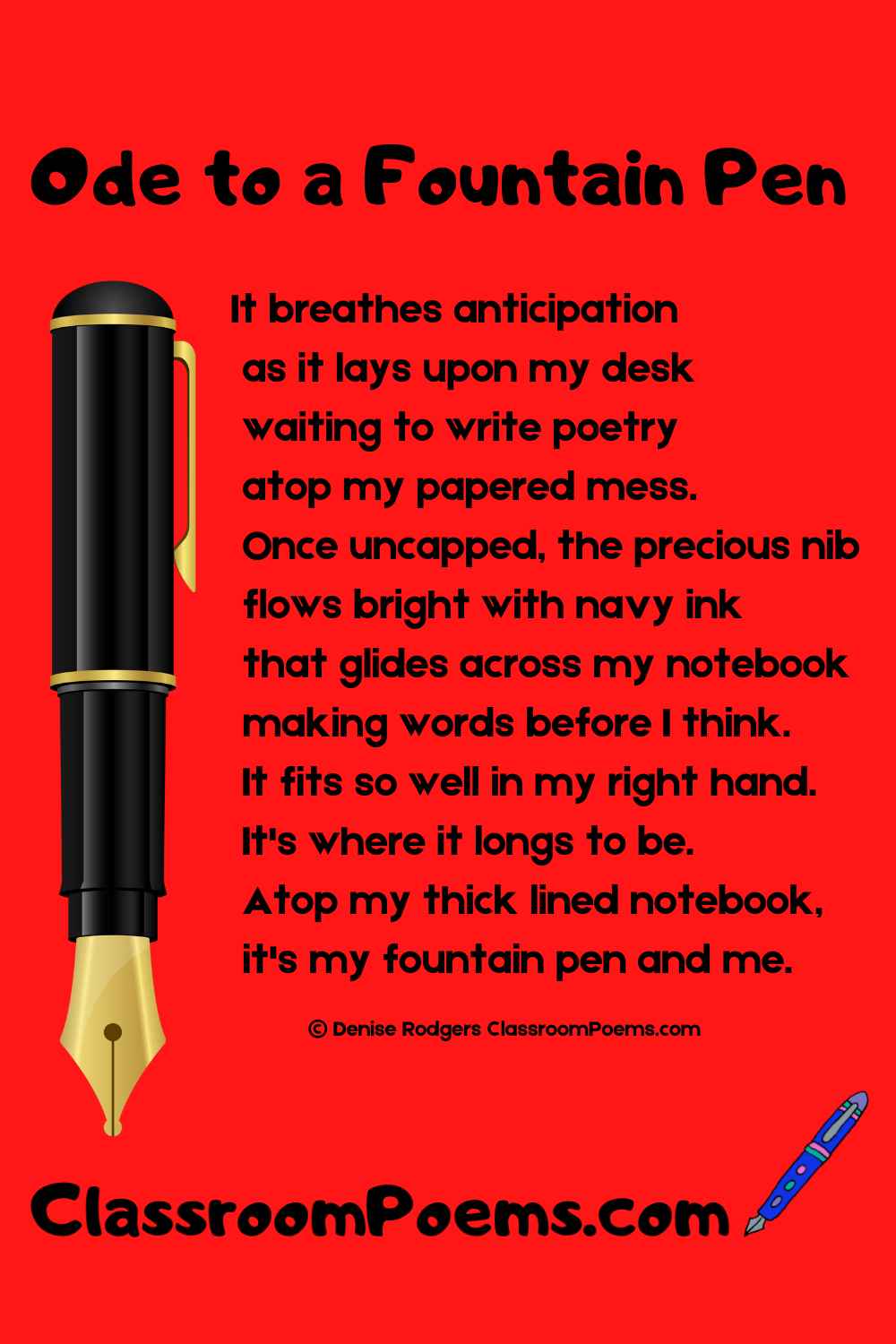How to Write an Ode
HOW TO WRITE AN ODE IN SIX EASY STEPS
#1 Choose a topic, someone or something you admire, as odes are celebration poems.
#2 Research your topic. Make notes of what you know, then add research in your library, online and more.
#3 Read through your research to find words or phrases that suggest a poem.
#4 Write your first draft. (It doesn't have to be good.)
#5 Edit your ode. Add and delete words. Polish it up!
#6 Share your ode with the world. Read it out loud to a friendly sudience. Print and share copies.
Ode Poem Definition
An ode is a poem written in celebration of the topic… be it a person, place or thing. This poetry form, originated in ancient Greece where odes were performed with a musical background, often to celebrate athletic victories. The English Romantic poets celebrated love and other emotions with their own version of ode poems. Today, in the age of personal expression. Odes are written in praise of whatever the poet sees fit. Me, I often write about my fountain pen. I like the way it writes smoothly on the page. See the ode poem example below.
An Ode Poem Example
ODE TO A FOUNTAIN PEN
It breathes anticipation
as it lays upon my desk
waiting to write poetry
atop my papered mess.
Once uncapped, the precious nib
flows bright with navy ink
that glides across my notebook
making words before I think.
it fits so well in my right hand.
It's where it longs to be.
Atop my thick lined notebook,
it's my fountain pen and me.
by Denise Rodgers
Copyright©Denise Rodgers
All rights reserved.
Permissions
Next we are going through the six steps for writing an ode poem of your own. Grab your notebook and pen (perhaps a fountaini pen?) and start writing.
How to Write an Ode ~ Step 1: Choose a Topic
Think about what you feel passionately about. Your local ball team? Your dog or cat? Your mom or dad? Your best friend? Your hobby? Your computer or tablet? Remember, this is a positive poem, so keep the topic to something or someone that you admire. Also, while the examples here all rhyme, you don’t have to make your poem rhyme. But if you choose not to rhyme, please make use of some of the other forms of wordplay: alliteration, simile, metaphor, onomatopoeia, personification, repetition, or any wordplay that comes to mind while writing the poem. Now is the time. Pick up your pen or pencil, open to a nice clean page in your notebook, and just start writing!
How to Write an Ode ~ Step 2: Research
First, write what you think you know and feel about your topic. Once you start writing, you might very well discover that you know more than you think. But don’t stop there. Ask questions. Get other people’s thoughts and opinions about your topic. Your next step is to look up your topic on the Internet or in your public library. Gather all the descriptions, facts, ideas and words you can. This is the raw material for your poem.
How to Write an Ode ~ Step 3: Read Over Your Research
Read over all the material you gathered in your research and see if any of the words suggest a line or phrase of poetry. It doesn’t have to be the first line. It doesn’t even have to be a line. It can be a phrase, or even just a word that sounds right to your ear. You might find more than one or two of these gifts. Circle them. Write them down. This is an important start.
How to Write an Ode ~ Step 4: Start Writing

Use your chosen words and phrases. Remember your first draft is just that: a draft. It doesn’t have to be “good.” It certainly doesn’t have to be a poem in your first go round. While writing, try to include as much of your material as you need. You might find that there is enough to say about your topic looking at it (or him or her) with a very narrow lens. For example: if you’re writing an ode to Abraham Lincoln, you need not include his childhood or infancy. You wouldn’t need to include his whole presidency. You might write only about his stovepipe hat or his relationship with his wife, or his final day at the theater (where he was assassinated).
How to Write an Ode ~ Step 5: Edit
While you might have edited and changed your ode while writing the first draft, it’s a good idea to let your ode sit and simmer awhile. Leave it for at least an hour, and maybe for a few days, if possible. When you read it again for editing, it should be with fresh eyes. Now is the time to read it out loud and listen to it with your ears. Listen for the rhythm. Poems are a short literary form and every word counts. This is the time to add and remove words, polishing, polishing, until the poem feels like it existed before you started writing it.
How to Write an Ode ~ Step 6: Share Your Ode with the World
Of course, you don’t have to share. You might enjoy saving a collection of your own work. I do this myself. I have every poem and journal I’ve ever written, and I’ve been at this since 1969 (That’s a lot of paper!) (And I started young. 😊) However, it’s a lot more fun to share your words with the world. Write it down, print it up, and hand it over for others to read. You can print them on special paper or even frame them and give them as gifts. If you have a school newsletter or a small local newspaper, you might consider sending it in for possible publication. And don’t forget, you can always share them on this site by going to our Kids Publish Poems page.
Well, that’s about all I have to say about odes. Odes are important poems. Now that you have all the steps you need to write one, why not get started right now? Grab a pen and notebook and happy writing!














